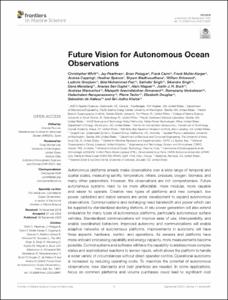| dc.contributor.author | Whitt, Christopher | |
| dc.contributor.author | Pearlman, Jay | |
| dc.contributor.author | Polagye, Brian | |
| dc.contributor.author | Caimi, Frank | |
| dc.contributor.author | Muller-Karger, Frank | |
| dc.contributor.author | Copping, Andrea | |
| dc.contributor.author | Spence, Heather | |
| dc.contributor.author | Madhusudhana, Shyam | |
| dc.contributor.author | Kirkwood, William | |
| dc.contributor.author | Grosjean, Ludovic | |
| dc.contributor.author | Fiaz, Bilal Muhammad | |
| dc.contributor.author | Singh, Satinder | |
| dc.contributor.author | Sen Gupta, Ananya | |
| dc.contributor.author | Singh, Sikandra | |
| dc.contributor.author | Manalang, Dana | |
| dc.contributor.author | Gupta, Ananya Sen | |
| dc.contributor.author | Maguer, Alain | |
| dc.contributor.author | Buck, Justin J. H. | |
| dc.contributor.author | Marouchos, Andreas | |
| dc.contributor.author | Atmanand, Malayath Aravindakshan | |
| dc.contributor.author | Venkatesan, Ramasamy | |
| dc.contributor.author | Narayanaswamy, Vedachalam | |
| dc.contributor.author | Testor, Pierre | |
| dc.contributor.author | Douglas, Elizabeth | |
| dc.contributor.author | de Halleux, Sebastien | |
| dc.contributor.author | Khalsa, Siri Jodha | |
| dc.date.accessioned | 2021-09-22T21:31:39Z | |
| dc.date.available | 2021-09-22T21:31:39Z | |
| dc.date.issued | 2020 | |
| dc.identifier.citation | Whitt, C., Pearlman, J., Polagye, B.,
Caimi, F., Muller-Karger, F. et al
(2020) Future Vision
for Autonomous Ocean Observations.
Frontiers in Marine Science, 7:697, 24pp.
DOI: 10.3389/fmars.2020.00697 | en_US |
| dc.identifier.uri | https://repository.oceanbestpractices.org/handle/11329/1724 | |
| dc.description.abstract | Autonomous platforms already make observations over a wide range of temporal and
spatial scales, measuring salinity, temperature, nitrate, pressure, oxygen, biomass, and
many other parameters. However, the observations are not comprehensive. Future
autonomous systems need to be more affordable, more modular, more capable
and easier to operate. Creative new types of platforms and new compact, low
power, calibrated and stable sensors are under development to expand autonomous
observations. Communications and recharging need bandwidth and power which can
be supplied by standardized docking stations. In situ power generation will also extend
endurance for many types of autonomous platforms, particularly autonomous surface
vehicles. Standardized communications will improve ease of use, interoperability, and
enable coordinated behaviors. Improved autonomy and communications will enable
adaptive networks of autonomous platforms. Improvements in autonomy will have
three aspects: hardware, control, and operations. As sensors and platforms have
more onboard processing capability and energy capacity, more measurements become
possible. Control systems and software will have the capability to address more complex
states and sophisticated reactions to sensor inputs, which allows the platform to handle
a wider variety of circumstances without direct operator control. Operational autonomy
is increased by reducing operating costs. To maximize the potential of autonomous
observations, new standards and best practices are needed. In some applications,
focus on common platforms and volume purchases could lead to significant cost reductions. Cost reductions could enable order-of-magnitude increases in platform
operations and increase sampling resolution for a given level of investment. Energy
harvesting technologies should be integral to the system design, for sensors, platforms,
vehicles, and docking stations. Connections are needed between the marine energy and
ocean observing communities to coordinate among funding sources, researchers, and
end users. Regional teams should work with global organizations such as IOC/GOOS
in governance development. International networks such as emerging glider operations
(EGO) should also provide a forum for addressing governance. Networks of multiple
vehicles can improve operational efficiencies and transform operational patterns. There
is a need to develop operational architectures at regional and global scales to provide a
backbone for active networking of autonomous platforms. | en_US |
| dc.language.iso | en | en_US |
| dc.rights | Attribution 4.0 International | * |
| dc.rights.uri | http://creativecommons.org/licenses/by/4.0/ | * |
| dc.subject.other | Autonomous vehicles | en_US |
| dc.subject.other | Remotely Operated Vehicle | en_US |
| dc.subject.other | Autonomous platforms | en_US |
| dc.subject.other | OceanObs19 | en_US |
| dc.title | Future Vision for Autonomous Ocean Observations. | en_US |
| dc.type | Journal Contribution | en_US |
| dc.format.pagerange | 24pp. | en_US |
| dc.identifier.doi | https://doi.org/10.3389/fmars.2020.00697 | |
| dc.subject.parameterDiscipline | Physical oceanography | en_US |
| dc.bibliographicCitation.title | Frontiers in Marine Science | en_US |
| dc.bibliographicCitation.volume | 7 | en_US |
| dc.bibliographicCitation.issue | Article 697 | en_US |
| dc.description.sdg | 14.a | en_US |
| dc.description.eov | N/A | en_US |
| dc.description.methodologyType | Reports with methodological relevance | en_US |
| obps.contact.contactname | Christopher Whitt | |
| obps.contact.contactemail | cwhitt@ieee.org | |
| obps.resourceurl.publisher | https://www.frontiersin.org/articles/10.3389/fmars.2020.00697 | |
 Repository of community practices in Ocean Research, Applications and Data/Information Management
Repository of community practices in Ocean Research, Applications and Data/Information Management

